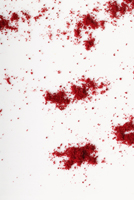Pernicious anaemia
 Disease caused by vitamin B12 defficiency was first described by Addison in 1855, and became known as Addison's anaemia or Biermer's anaemia. The symtoms included palor, shortness of breath, jaundice, weight loss and muscle spasms. The cause of the disease was unknown, and it was generally fatal.
Disease caused by vitamin B12 defficiency was first described by Addison in 1855, and became known as Addison's anaemia or Biermer's anaemia. The symtoms included palor, shortness of breath, jaundice, weight loss and muscle spasms. The cause of the disease was unknown, and it was generally fatal.
The first treatments for pernicious anaemia were devised by George Whipple, who studied anaemia in dogs. He was studying the effects of blood loss on dogs. He set out to investigate the effects of diet on anaemia, and bled dogs until they became anaemic, feeding them special diets and noting the effects on their recovery. He found that dogs which ate large amounts of liver recovered quickly from anaemia due to blood loss. He went on to investigate the effects of liver consumption on pernicious anaemia, and in 1920 he published a paper on how eating liver had beneficial effects on sufferers of pernicious anaemia.ANCHOR
George Minot and William Murphy investigated which factor in the liver was responsible for the treatment of anaemia in dogs, and found that it was iron. They also discovered that a soluble factor in the liver juices was responsible for the effects on pernicious anaemia. The fact that consuming liver treated both conditions turned out to be a coincidence. These findings were published in 1926ANCHOR, and they shared the Nobel Prize for medicine with Whipple in 1934 for the treatment for pernicious anaemia.
In 1928 a liver extract which was 50-100 times more potent than liver itself was developed by a chemist, Edwin Cohn. The extract could be injected, which was a great improvement on the previous treatment of eating large quantities of liver.
In 1948 chemists Karl Folkers and Alexander Todd isolated the active component from liver extract, which they named vitamin B12. The structure of vitamin B12 was determined by Dorothy Hodgkin in 1956ANCHOR, enabling new methods of production to be developed in the late 1950's.
Since then, bacteria can now be used to produce vitamin B12 in large quantities, and pernicious anaemia has been easily diagnosed. It is no longer the fatal disease that it once was, and can be easily treated by injections of vitamin B12.
References
- 1. G. H. Whipple, F. S. Robscheit and C. W. Hooper (1920) Blood regeneration following simple anemia. IV. Influence of meat, liver and various extractives, alone or combined with standard diets.
American Journal of Physiology, 53: 236-262 - 2. Minot G. R. and Murphy, W. P. (1926) Treatment of pernicious anemia by a special diet, JAMA 87:470-6
- 3. Hodgkin, D. C., Kamper, J., Mackay, M. and Pickworth, J. (1956) Nature, 178, 64
Last edited: 3 November 2014 13:11
